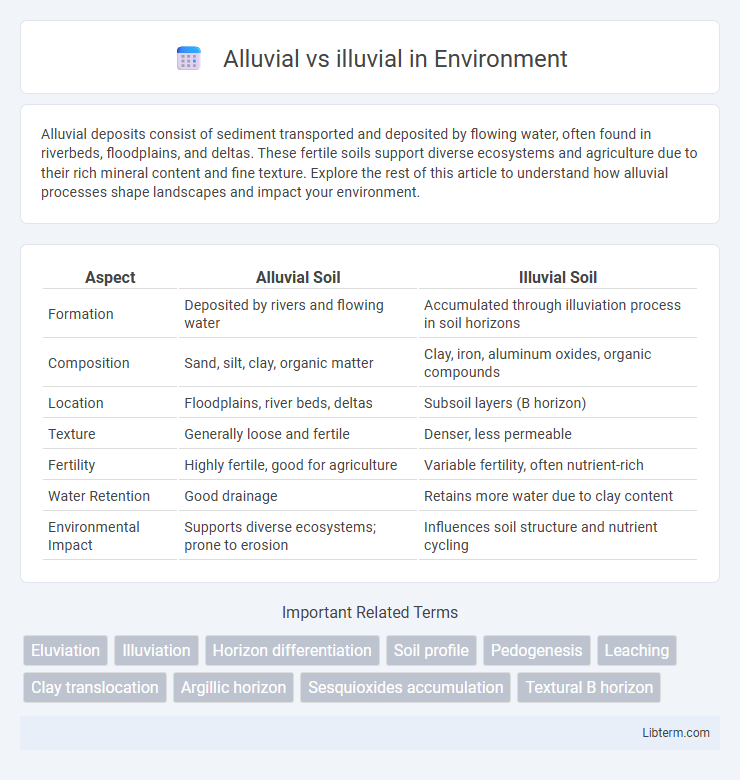Alluvial deposits consist of sediment transported and deposited by flowing water, often found in riverbeds, floodplains, and deltas. These fertile soils support diverse ecosystems and agriculture due to their rich mineral content and fine texture. Explore the rest of this article to understand how alluvial processes shape landscapes and impact your environment.
Table of Comparison
| Aspect | Alluvial Soil | Illuvial Soil |
|---|---|---|
| Formation | Deposited by rivers and flowing water | Accumulated through illuviation process in soil horizons |
| Composition | Sand, silt, clay, organic matter | Clay, iron, aluminum oxides, organic compounds |
| Location | Floodplains, river beds, deltas | Subsoil layers (B horizon) |
| Texture | Generally loose and fertile | Denser, less permeable |
| Fertility | Highly fertile, good for agriculture | Variable fertility, often nutrient-rich |
| Water Retention | Good drainage | Retains more water due to clay content |
| Environmental Impact | Supports diverse ecosystems; prone to erosion | Influences soil structure and nutrient cycling |
Understanding Alluvial and Illuvial: Key Definitions
Alluvial refers to sediments deposited by flowing water, typically found in riverbeds and floodplains, characterized by loose, unconsolidated soil or gravel. Illuvial describes the process of accumulation or deposition of materials like clay, iron, or organic matter in a soil horizon, often observed in subsoil layers. Understanding alluvial and illuvial processes is crucial for interpreting soil formation, nutrient distribution, and landscape evolution.
Formation Processes of Alluvial and Illuvial Layers
Alluvial layers form through sediment deposition by water flow, typically in riverbeds, floodplains, and deltas, where particles like sand, silt, and clay accumulate and create stratified soil profiles. Illuvial layers develop beneath the soil surface as materials such as clay, iron, and organic matter translocate from upper horizons and accumulate due to leaching and eluviation processes. The contrasting formation processes result in alluvial soils characterized by surface deposits from water transport, whereas illuvial layers are defined by subsurface enrichment through downward movement within the soil profile.
Distinct Physical Characteristics
Alluvial deposits consist of loose, unconsolidated sediments like sand, silt, and clay transported by flowing water, exhibiting well-sorted, rounded particles with high porosity and permeability. Illuvial deposits show accumulation of materials such as clay, iron, or organic compounds within soil horizons due to translocation, characterized by denser, finer textures and lower permeability compared to alluvial layers. The distinct physical characteristics stem from alluvial deposits forming in active sedimentary environments versus illuvial deposits resulting from soil horizon differentiation and material leaching.
Chemical Composition Differences
Alluvial soils typically have a higher concentration of minerals like quartz, feldspar, and organic matter resulting from sediment deposition by water movement, making them rich in nutrients like calcium and magnesium. Illuvial soils are characterized by the accumulation of clay, iron, and aluminum oxides washed down from upper soil horizons, leading to a higher content of silicon dioxide and aluminum hydroxides. The chemical composition differences influence soil fertility and structure, with alluvial soils generally being more fertile due to nutrient accumulation, whereas illuvial soils often exhibit higher levels of leached elements and complex clay minerals.
Role in Soil Horizons
Alluvial processes involve the deposition of sediments by flowing water, primarily impacting the A and E horizons by adding mineral particles and organic matter. Illuvial processes concentrate materials like clay, iron, or organic compounds in the B horizon through downward movement and accumulation, forming distinct illuviation layers. The contrasting roles of alluvial and illuvial actions shape soil profile development, influencing nutrient distribution and soil texture in various horizons.
Impact on Soil Fertility
Alluvial soils, formed by river sediments, are rich in nutrients and minerals, promoting high soil fertility ideal for agriculture. Illuvial soils accumulate clay, iron, and organic compounds through leaching, leading to dense layers that can restrict root growth and reduce permeability, potentially decreasing fertility. Understanding the balance between nutrient deposition in alluvial soils and nutrient leaching in illuvial soils is crucial for soil management and crop productivity.
Typical Environments and Occurrence
Alluvial deposits typically occur in riverbeds, floodplains, and deltas where flowing water transports and sediments materials such as sand, silt, and clay. Illuvial horizons develop within soil profiles, especially in forested or temperate regions, where fine particles, organic matter, and minerals accumulate through processes like clay translocation and iron or aluminum oxide deposition. Alluvial environments are dynamic and externally influenced by surface water flow, while illuvial zones reflect internal soil formation and pedogenic processes.
Importance in Agriculture and Land Use
Alluvial soils, rich in minerals and nutrients deposited by rivers, are highly fertile and crucial for intensive agriculture, supporting crops like rice, wheat, and maize. Illuvial soils, formed by the downward movement and accumulation of clay, iron, and organic matter, influence soil structure and water retention, affecting crop root development and land management practices. Understanding the distribution of alluvial and illuvial soils guides sustainable land use planning and maximizes agricultural productivity in diverse environments.
Environmental Implications
Alluvial soils, formed by river deposits, are typically nutrient-rich and support diverse ecosystems but are prone to flooding and erosion, impacting land stability and water quality. Illuvial soils result from the accumulation of minerals leached from upper layers, influencing soil fertility and water retention, which affects vegetation patterns and groundwater recharge. Understanding these soil formation processes helps in managing land use, preventing degradation, and promoting sustainable agriculture and conservation efforts.
Summary: Choosing Between Alluvial and Illuvial Soils
Alluvial soils form from river-deposited sediments, providing fertile, well-drained grounds ideal for agriculture and crop cultivation. Illuvial soils result from the accumulation of materials like clay or iron oxides within soil horizons, often leading to less permeability and challenges for root growth. Selecting between alluvial and illuvial soils depends on drainage requirements, nutrient availability, and crop type suitability, with alluvial soils generally favored for high-yield farming due to their rich, loose texture.
Alluvial Infographic

 libterm.com
libterm.com